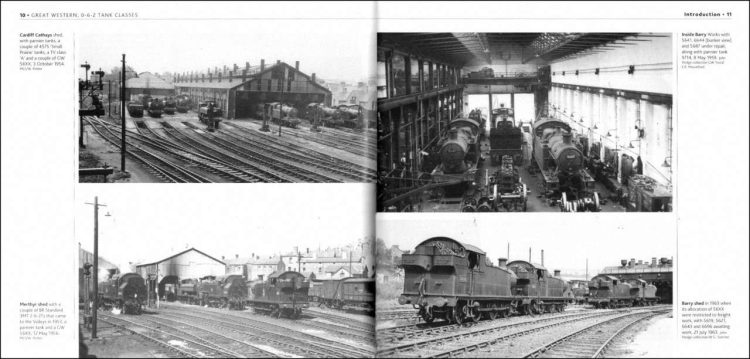Published in August 2020 as part of Pen & Sword's “Locomotive Profiles” series, this book describes the Great Western Railway's ubiquitous 0-6-2 tank engines, many of which the company inherited from railways in South Wales at the 1923 Grouping.
This hardback book from publishers Pen & Sword and written by David Maidment, is presented in landscape format, measures around 26 cm x 24.1 cm, has 272 pages, and 300 black and white illustrations. It has a published price of £30, and at the time of writing, it can be purchased online from Amazon for £21.31.
What struck me at first sight of the book was the large number of photographs, many dating back well over a century. The main body of the book is preceded by brief biographies of the engineers responsible for designing the locomotives for both the Great Western Railway and its constituent companies in South Wales.
The first six chapters follow the same format, with a route map for each company, construction details and history of each company's locomotive types, and many photographs of each. The major pre-grouping companies, namely the Barry, Cardiff, Brecon & Merthyr, Rhymney, and Taff Vale Railways each have a dedicated chapter, while the smaller companies follow in a single chapter that includes the Alexandra Docks and Railway Company, Neath & Brecon, Port Talbot, and Rhondda & Swansea Bay Railways.
There follows a large chapter of 60 pages describing the Great Western's 56XX and 66XX Classes, which includes build details and allocations from when they were built, and in 1947, 1953, 1960, and 1963, and when they were withdrawn. What is striking is the rapid decline between 1960 and 1963.
The final chapter describes those 0-6-2 locomotives that have been preserved and their preservation history. That is followed by an impressive appendix that provides outline weight diagrams, dimensions, and technical details for each class covered by the book, and includes both the original railway's running number, its later Great Western Railway number, build and withdrawal dates, boiler type, and allocations.
Because of the large number of different branch lines, a relatively large number of engine sheds were required to maintain the branches' locomotives, just a few of which are illustrated below.

The pages below show an example of the introduction to each railway's chapter. The map shows how many of the companies' lines overlapped and has the right level of detail to be useful, but would have been better if colours could have been used to differentiate between the different companies rather than various types of dashed lines. A scale showing approximate mileages would also have been helpful.
When the 0-6-2 tank engines of the South Wales railway companies were absorbed into the Great Western Railway, they were renumbered to avoid duplication. To anyone unfamiliar with them, locomotives with two- and three-digit numbers such as the ones on the left-hand page below always seemed unusual. The map on the right-hand page shows clearly the many branch lines emanating from Cardiff, from which it is easy to understand why the various companies required just so many locomotives for use in such a comparatively small area.
Sixty pages are devoted to a very-interesting chapter describing many aspects of Great Western's 56XX and 66XX Classes. The pages below are typical of the chapter, including allocation details as seen on the left-hand page below, and a large number of photos such as those on the right.
A brief summary is provided for each example that has been preserved, as on the left-hand page below, while the right-hand page is the first of the 47 pages in the Appendix illustrating the level of technical details included for each class, including their dimensions and weight diagrams.
In summary, this is an excellent volume for anyone interested in the archetypal locomotives of South Wales. The level of technical details was just right, while the allocation records of all locomotives was interesting. Maps detailing the extent of operations of each railway company were useful, although I would like to have seen an approximate scale. The compact size of the locomotives would make them ideal for a railway modeller, and the large number of photographs will prove an invaluable source of information. A commendable gesture is that all royalties go to the Railway Children charity, which was founded by the author. An excellent book with a large number of photographs and a good addition to a railway enthusiast's bookshelf. Highly recommended.
The book is available to purchase from Amazon and from Pen & Sword.
We would like to thank Pen & Sword for providing RailAdvent with a copy of the book for review.